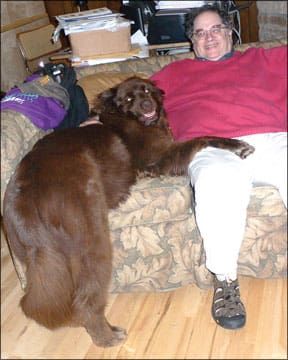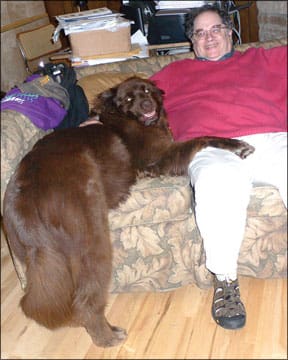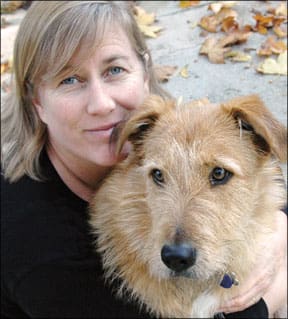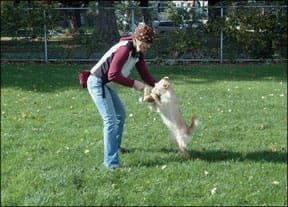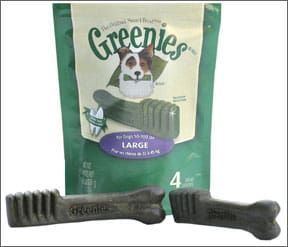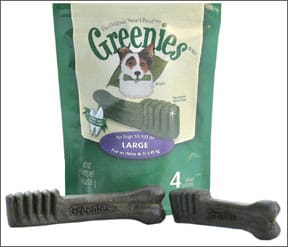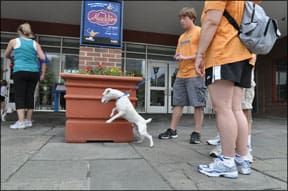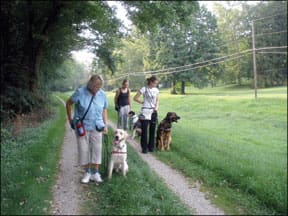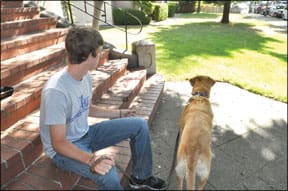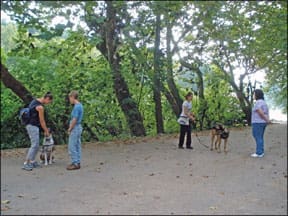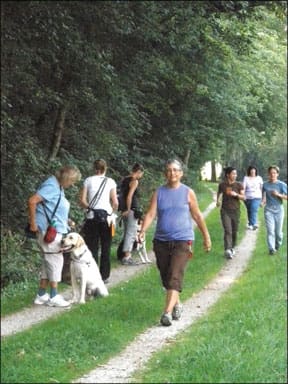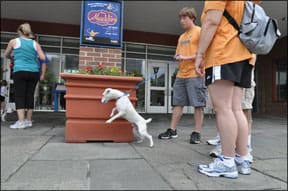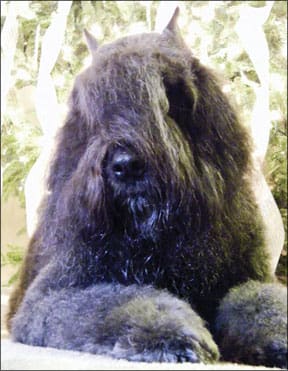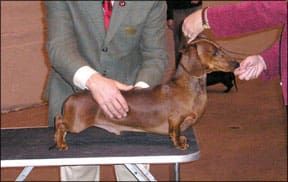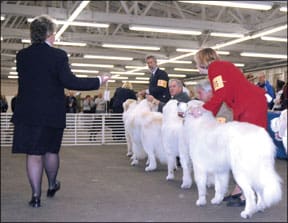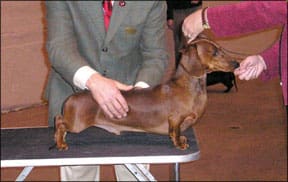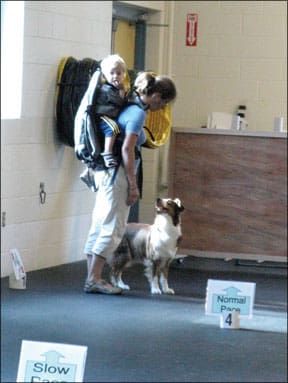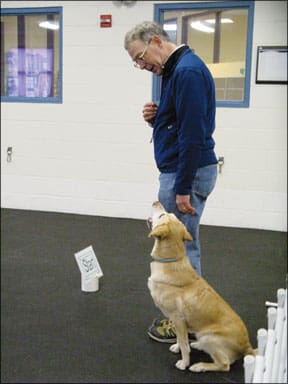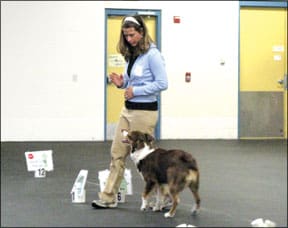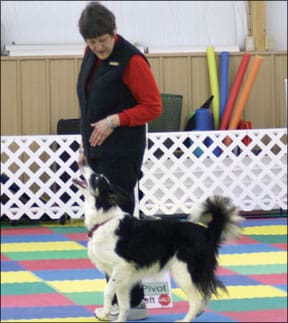Snapping fingers and tapping feet are the signature moves of musical freestyle – and that’s the audience! What happens between dog and handler during a musical freestyle performance is simply magical. The handler gives subtle cues, and her dog executes complicated maneuvers, one after the other, as the pair moves across the floor, their routine choreographed to music that emphasizes their connection.
For those of you whose introduction to this sport was watching a widely distributed video clip of Carolyn Scott’s routine to “Grease” with her Golden Retriever, Rookie, you were probably awestruck. You may have even gotten a little misty eyed, recognizing the commitment, training, and connection between two different species. But it was the look on Rookie’s face that sold you that this was a sport worth exploring. This dog was having a blast, and the behaviors he was doing were difficult! How could training something so hard be so fun?

Photo by Brenda Cutting
288
“I first saw freestyle in 1997, a video of Donna Duford and her PBGV (Petit Bassett Griffon Vendeen),” recalls freestyle judge and instructor Julie Flanery. “In 1998 I saw it live for the first time at a demonstration at an APDT (Association of Pet Dog Trainers) conference. I was amazed at what these dogs were doing and how much fun it looked. I had to do this with my dog!”
Flanery has since become one of the sport’s most ardent boosters, convincing many people to give this sport a try even in the sport’s early days in her area of the Pacific Northwest. “Most of my early freestyle training was on my own by watching others and then figuring out how to train it using positive reinforcement methods. I had to do a lot of problem solving early on and came up with several of my own methods. I also took several workshops, sometimes traveling great distances to learn from top performers.”
Flanery added freestyle to the list of classes she was teaching at the time, cajoling several of her students to give it a try. “That small group of six friends created the first freestyle club on the West Coast, Dogs Gone Dancin,’ now with almost 50 members in Oregon, Washington, and British Columbia.”
Since then, Flanery has stayed so active in the sport that she has been invited to present workshops in South Africa, has presented numerous workshops in the U.S., has become a judge for the World Canine Freestyle Organization (WCFO), and, of course, put advanced freestyle titles on her own dogs. All from just watching that one demonstration. Watch out; this sport can be addictive!
The game
There are two major styles of dog dancing, as this sport is also known. One is heelwork to music, or canine dressage, which focuses on setting precise heelwork (in close to proximity to the handler) to music. Musical freestyle, on the other hand, allows any movement or combination of movements, in close proximity or at a distance, as long as the movements are safe for the dog.
Music is chosen based on a dog’s gait, with faster tempos for the quick-moving dogs and a more moderate beat for dogs that naturally move slower or are larger in structure. Handlers memorize the music, break it down into segments, choreograph movements for themselves and their dogs, and then string it all together. The result can be breathtaking, hilarious, dramatic, or a combination of all three.
If you have never seen a freestyle routine, you might want to power up your computer, go to YouTube.com, and type “canine musical freestyle” in the “search” field. You’ll find a wide variety of clips. Carolyn Scott’s “Grease” routine has had more than 5 million viewers. Look at a few of the “most viewed” clips and you’ll see why this sport is so fun and challenging.
At its core, musical freestyle is the art of training individual tricks such as spin, twist, back up, leg weaves, circling around the handler, side stepping, etc., and then training your dog to do multiple tricks in a row while you move around at the same time. Cindy Mahrt was one of the people Flanery enrolled in one of her classes in 2000. Mahrt attended with her 18-month-old Rottweiler, Gitta.
“I wanted to keep Gitta in some sort of class to keep up her socialization skills,” recalls Mahrt. “Gitta and I had gone through all the normal classes – puppy, beginners, advanced beginners; we even tried a tricks class. When Julie decided to try a freestyle class, she asked if we were interested. It was way more fun than doing basic obedience over and over. A small group of us tried it one night; it was a little crazy, but fun, and I was hooked.”
Mahrt had never competed in a dog sport before and had no intention of doing so in freestyle. However, Flanery’s enthusiasm was infectious and Gitta just loved the sport. “I swore I would never compete,” says Mahrt. “I just couldn’t see myself going out in public and dancing with my dog in a costume. I wasn’t comfortable with the whole idea of competition. I just wanted to have fun with Gitta and the friends I’d made in class. At that time, there weren’t many opportunities to compete, so it wasn’t much of an issue.”
History
Freestyle in North America goes back to 1989 when Val Culpin of British Columbia, Canada, started developing the sport. Trainers in England were on a similar path, with top obedience competitor Mary Ray wowing crowds with her demonstrations at Crufts, the top conformation, obedience, and agility competition event in Britain.
Throughout the 1990s, the sport continued to grow in Canada, the U.S., and Britain. The Canada-based Musical Canine Sports International (MCSI) was launched to write rules and judging guidelines. Its first U.S. competition was held in 1996 in Springfield, Oregon.

Rainbow River Photography
288
Throughout the years, different styles of the sport developed, including heelwork to music and musical freestyle, as well as a distinctly theatrical style with highly costumed competitors and dramatic story lines. Bring up YouTube.com on your computer’s Web browser again and search “Attila and Fly, Gladiator” for an excellent example of this more theatrical style. The sport has continued to evolve throughout the world, and additional organizations have sprung up to support different approaches and philosophies. (See Snapshot of the Sport, below.)
Attributes of dancing dogs and handlers
A wide variety of breeds and mixes participate in this sport. Freestyle training is great for fearful dogs, too, since only one dog competes at a time, and the training culture in freestyle is one of using positive reinforcement methods.
Positive methods help build dogs’ confidence and trust, and this was an attraction for Mahrt when she decided to try freestyle. “Gitta really responded well to positive reinforcement training. When we first started [obedience] classes, it was mostly positive, but switched back to traditional methods when any problems arose. This just didn’t work with Gitta; it only made things worse. It was wonderful to start freestyle and switch to only positive reinforcement. We do a lot with clicker training and shaping.”
Flanery believes that freestyle appeals to many kinds of people, but especially “those who enjoy music, enjoy the teamwork between dog and handler, who seek a creative outlet for themselves and their dogs, and who are willing to step outside of their current skill set and learn new things, such as music editing, choreography, and presentation.”
Equipment & supplies
Although some trainers use some props in their routines (e.g., a cane, a stool, a handkerchief), all that is required is you and your dog. With the exception of the more theatrical routines, costumes are not essential although most people dress in a manner that supports their routine. For example, a team performing to country music might wear a western-themed shirt and jeans.
You will need a boom box or other music player to play your music, and it is helpful to have one that is easy to pause, rewind, and find your place again. A remote control can be helpful for this. Handlers use pen and paper and sometimes rally obedience signs and software to map out their choreography. Otherwise, standard training supplies (clicker and treats) are all you need.
Expenses
This is a relatively inexpensive sport. Gas and lodging will probably be your biggest expense if you intend to compete in person. If you can find a class in your area, they are typically similar in cost to basic pet manners classes. An alternative to a freestyle class is to enroll in a tricks class to build your repertoire of behaviors.
Competition fees run about $30 per class per event. Live competitions are still far and few between so you might compete only once or twice a year, and video competitions are only scheduled a few times a year as well. Membership in one of the sponsoring organizations varies. For example, an annual membership in the WCFO is $30.
Training
This is a deceptively difficult sport. It looks like so much fun that one forgets that each behavior must be trained to mastery before putting them together in a routine.
Professional trainers like to say, “A behavior chain is only as strong as its weakest link.” If one of your behaviors, e.g., leg weaves, falls apart in the middle of a routine, it can be difficult to get the routine back on track.
Flanery points out, “As freestyle competitors we are asking our dogs to perform anywhere from 30 to 80 (or more!) cued behaviors in a span of a minute and a half to four minutes depending on the level entered . . . there is a lot of multi-tasking that goes on in the freestyle ring. Both the dog and the handler are working hard. The dog, attentive, following cues and performing with as much precision as possible, always ready for the next cue; the handler, listening to the music cues, cueing the dog’s moves, keeping her choreography straight, and readjusting for missed moves or cues.”
The prerequisite behaviors that set teams up for success are those brought from basic pet manners: attention, sit, stay, down, and heel (walk in position next to you). Of these, attention and heel in position are the most important. While polishing those basic skills, you can also be training a variety of tricks, the foundation of what you see in a freestyle routine.
Most important for handlers who want to excel in freestyle is a solid understanding and hands-on experience with positive reinforcement and, in particular, clicker training. The clicker excels as a “behavior marker,” quickly and accurately (in the hands of a skilled trainer) identifying the smallest pieces of a full behavior that might be difficult to get with other methods.
For example, imagine that you want to train your dog to lift a front foot off the floor and hold it in space for two seconds. It might be difficult to lure that behavior (using a treat to move your dog in the direction you want). With the clicker and good observation skills, you can click for the slightest shift of weight. Dogs that have been clicker trained understand that the click happened for something very specific and they soon figure out what it is. The art of “shaping” behavior this way also makes it easier to motivate your dog to work with you even if you don’t have a treat in front of her nose.
Flanery has used a combination of luring and clicker training to train many of the creative and complex behaviors she has taught over the years. “While there are freestylers who don’t use a clicker, I believe strongly that to get to the upper levels of creativity, a dog and handler team should focus on building solid clicker skills and an understanding of operant conditioning. It is often the dog who comes up with the most creative behaviors, and if you don’t understand how to draw that out of your dog, then you are missing out on one of the most amazing aspects of freestyle.”
Training freestyle, even if you choose not to compete, has additional benefits. As with many dog sports, an amazing connection between human and dog blossoms through the training process. This is especially true for dogs with behavior issues or physical challenges. Cindy Mahrt’s Rottie, Gitta, had both. Now 11 years young, Gitta’s freestyle training was interrupted in 2003 when she underwent anterior cruciate ligament knee surgery at age five and then a year later for the other knee. She had also always been a bit fearful, and being out of commission for almost two years for her surgeries and recovery was a set back for Mahrt who had worked so hard to train and socialize her dog.
“We suddenly were very restricted in what she could do for those couple of years. Freestyle is a great sport for building up muscle tone. Dogs do a lot of rear work – backing up, side passes, circling around backward, backward weaves, etc. All of these take an awareness of their rear ends that most dogs don’t have. I think it really helped her recovery.
“Being sidelined by two surgeries kept her pretty isolated for awhile. Gitta is very reactive to dogs she doesn’t know. Freestyle got me working with clicker training and positive reinforcement. They are very useful and important tools in dealing with a reactive dog. Giving her something else to focus on is also important. If a new dog comes into class, I can have her do spins, circles, weaves, etc., and get a big treat; she forgets all about the other dog. Pretty soon that dog isn’t so scary anymore.”
Levels of competition
Each organization has its own rules for heelwork to music and musical freestyle. Judging takes into consideration creativity, variety, and audience appeal. Specifics such as how much floor space must be covered in a particular level or division will be covered and guidelines provided that help handlers decide the number of behaviors they want to showcase in a given performance.
Both WCFO and MDSA have a system for handlers to submit videotape of their performance for judging, so you can “compete” without having to always travel long distances.
What if you don’t want to compete? Many people start out thinking that competition is not their cup of tea. Mahrt remembers her own reluctance to compete. “Then I figured I could at least try it, once, but without a costume. I guess you can see where this is going,” Mahrt says wryly. “Although I don’t have a fancy costume – I usually wear nice black trousers and a velvety black shirt – I do now compete. I think it was 2001 that we had our first competition in Washington. We did pretty well; that was our first beginner’s leg. It took a long time after that to get the next leg and move up the ladder. The surgeries and stage fright – hers, not mine (well, a little mine) – slowed us down for a while.
“We compete through WCFO in live competitions. We got our Beginner and Novice titles. It then became obvious that physically she could not compete any longer in the regular divisions. WCFO is a great organization for its inclusion of everyone. I’m happy to say that Gitta and I earned our Championship title in the Handi Dandi division last May. We are now going to start over in the Sassy Senior division, for dogs older than nine years.”
How to get started
Contact one of the sponsoring organizations to find out if there are any instructors or member clubs in your area. If there aren’t, do what Julie Flanery did. Watch some videos, get inspired, and share your enthusiasm with your friends. Many freestyle groups start when friends meet at a park and train together, sharing music, tricks, and choreography tips. Find a local clicker trainer or training facility that uses positive reinforcement and, if they don’t offer freestyle, convince them to bring someone in to present a seminar to get you started.
Is this sport for you?
There are many aspects of freestyle that may appeal to you: the fun in just spending time with your dog, the challenges of competition, or sharing your routines with nursing home residents through therapy dog visits or doing public demonstrations. This is truly a sport that, at its core, expresses the deep potential within the human-canine bond.
Now, go grab those dancing shoes!
Terry Long, CPDT, is a writer, agility instructor, and behavior counselor in Long Beach, CA. She lives with four dogs and a cat and is addicted to agility and animal behavior.



